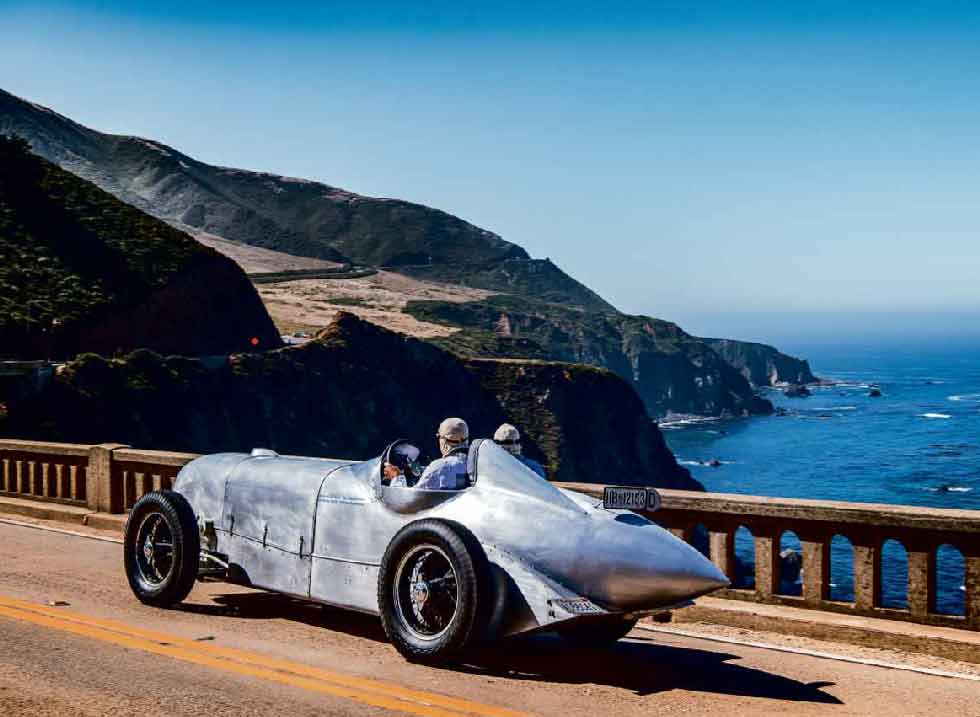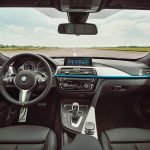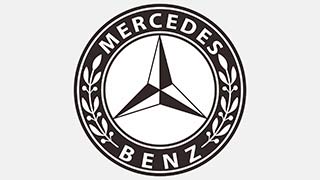
A 1932 Mercedes-Benz SSKL Type WS 06 RS with a wind-cheating body brought a new science to racing-car design. Nine decades on, it has been recreated. Words Massimo Delbo. Photography Mercedes-Benz Classic.
THE FIRST SILVER ARROW MERGEOES-BENZ SSKL STREAMLINER
The very first Silver Arrow no longer exists – so Mercedes-Benz re-created it
Those initials are legendary, of course, but have you ever seen an SSKL – Super Sport Kurz Leicht, alias Super Sport Short Light – that looks like this one? Probably not, because the original car vanished long ago, but now the Mercedes-Benz SSKL Streamliner is made metal once again. But how, why and by whom?

Before the answers are revealed, there is much context to set. The SSKL, as a breed, symbolises the final evolution of the six-cylinder kompressor car built and developed by Mercedes-Benz, This sports series began in 1927, equipped with a 6.2-litre supercharged engine and designated by a letter ‘S’ for Sportwagen. A year later it evolved into the SS (Super Sportwagen) with a 7.1-litre engine, and in December 1928 Mercedes-Benz presented the SSK (K for Kurz, ‘short’) with a chassis shortened by 42cm. It could be ordered with a bigger supercharger, and 33 such cars were built up to 1932.
So far, so speedy, but there was more to come. At the beginning of 1931, Mercedes’ head of development, Dr Hans Nibel, revealed the model line’s ultimate version. He and his designers, Max Wagner and Fritz Nallinger, had created the Type W 06 RS SSKL – but it was not to be offered for sale, and only four cars were built. Two were reserved for the works racing team, one was delivered to Count zu Hohenlohe-Bartenstein and the fourth was handed over to Baron Hans von Zimmermann, the sponsor and cousin of up-and-coming racing driver Manfred von Brauchitsch.
Every possible effort was made to reduce the SSKLs weight, and it lost 125kg in total relative to the SSK. The idea was to get as close as possible to a 50:50 weight distribution and this, with the short wheelbase and yet more power, made an explosive combination, especially when activating the blower boosted the regular 240bhp to 300. In April 1931 Rudolf Caracciola and his co-driver Wilhelm Sebastian won the Mille Miglia in their SSKL, the first non-Italians to do so, setting a record average speed of 101.1km/h – the first time the winning average had exceeded 100km/h.
Caracciola had entered the race as a privateer, but the works team was behind him with Mercedes’ legendary racing team manager, Alfred Neubauer, present in Brescia, The successes of the SSKL, and of Caracciola, continued through the whole season, with victories at the Eifel Race, the German Grand Prix, the Avus Race and five wins in five races in the sports-car category of the European Hill Climb Championship.

For the 1932 season Mercedes-Benz, still suffering under the global economic crisis, continued to support private racing teams and drivers rather than running a works effort, that was the arrangement for the Avus race of 22 May, backing the efforts of Hans Stuck and Manfred von Brauchitsch. The latter was to use his SSKL, most likely not the car he was given the previous year, which had been returned to the factory, but another one of the four. It was equipped with an aerodynamic body, a Stromlinien or Streamliner, designed by mechanical engineer Reinhard Baron von Koenig-Fachsenfeld especially for the circuit.
The 19.5km (11.9 miles) Automobil-Verkehrs und UbungsStrafie, or Automobile Traffic and Training Road, had opened in September 1921 in the south-west of Berlin as a normal highway, but it also formed the basis of a very unusual racetrack, the two long straights of the carriagewaywere linked by banked, long-radius corners at each end. The north curve was notable for its steep 43° banking, which made possible some incredible speeds, at the time the fastest seen on a racing track. Parts of the Avus track, still used for racing up to 1998, remain visible today, and the straights are incorporated into Bundesautobahn 115.
Body designer von Koenig-Fachsenfeld, born in Stuttgart in 1899 and a successful motorcycle racer, had developed a strong interest in aerodynamics while studying at Stuttgart Polytechnic. Back then the science was mostly applied to aircraft, but he was determined to extend it to cars. Meanwhile Manfred Georg Rudolf von Brauchitsch, born in Hamburg in 1905, knew that an SSKL with normal bodywork would have been hopeless on the fast Avus. But with a Stromlinien body, it could be a different story.
Trouble was, he couldn t afford to have one made. Alfred Neubauer, however, liked the idea and suggested to von Koenig-Fachsenfeld that he should design a real body according to his concept, The Vetter bodyshop, based in Cannstatt, near Stuttgart, and which also provided some funding, was commissioned to build it. Time was short, von Brauchitschs team was having problems in preparing the chassis for the race, and the Vetter bodyshop was left with just two weeks to develop and build the body, There wasn’t even time to paint the car in the national racing colour of white, so the SSKL Stromlinien body stayed in the natural silvery hue of its aluminium alloy.
To save time, and to do some testing on the way, the SSKL was driven from Cannstatt to Berlin. It was still far from ready on arrival, and practising for the race was wracked with problems, The onlookers, estimated to number a quarter of a million, nicknamed the car ‘Gherkin’, not the ideal sobriquet for a car that was about to face the competition of such drivers as William Grover-Williams (Bugatti Type 51), Sir Malcom Campbell (Sunbeam Tiger), Rudolf Caracciola (Alfa Romeo Monza), Rene Dreyfus (Maserati V5) and Luigi Fagioli (Maserati 8C 2800).
As soon as the race started, though, it was clear that the sleek and silver SSKLs problems were solved. Alfred Neubauer, horrified when he first saw the streamlined machine but delighted by its lap times, had ordered an overnight engine overhaul before the race and the installation of a rear axle with a longer gear ratio, The pay-off for the reduced engine speed on full-speed sections was poorer acceleration out of the two corners, but the overall result was a faster Stromlinien.
Soon the race had become a private affair between von Brauchitsch and Caracciola, the former gaining on the straight, the latter on the corners. To the excitement of the crowd, and the thousands of people following the race on the Sudwestdeutsche Rundfunkdienst AG radio station, radio reporter Paul Laven (one of the first live reporters) called the silver racing car whizzing past him to victory the ‘Silver Arrow’. Its average race speed was an astonishing 194.4km/h, or 120.8mph.
This was the first time that the Silver Arrow description, which became the German racing ‘brand’ from 1934 onwards, was known to have been used. After the race, von Brauchitsch joined the works Mercedes team and became one of the top drivers of the era, and Mercedes- Benz enthusiastically applied aerodynamic principles to its future racing cars, The SSKL Stromlinien, however, ran in just one more race: the Eifelrennen at the Nurburgring on 29 May, where it finished fourth. After that, as often happens with racing cars, it simply disappeared into oblivion.
After the Avus success, Baron von Koenig- Fachsenfeld declared: ‘Von Brauchitsch has proved to be a top-class racing driver and tactician. However, personally I value it more that he trusted me with his SSKL chassis to conduct a streamlining test. To me it was just a calculation, but for him it was an experiment.
Today anyone wanting to race at Avus must look into the issue of aerodynamics. It’s now merely a question of costs; there is no longer any associated risk, because von Brauchitsch has paved the way and others will follow.’
‘I have always been fascinated by the SSKL Stromlinien because of its importance in Mercedes-Benz racing history,’ says Mercedes-Benz Classic Center technician Michael Plag, in charge of the SSKL reconstruction project, ‘The aerodynamic study done for this car changed the design principles for racing cars.
‘When I studied Baron von Koenig-Fachsenfeld’s archive, I was impressed by how accurate and advanced his ideas were, The design covered the entire frame, including the underbody. A deflector in front of the steering wheel guided air over the driver’s head, and the head restraint featured an aerodynamic covering flowing down onto the body, These are all important details.
‘Taken together, these features improved the SSKLs aerodynamic efficiency by 25% and allowed a top speed of 230km/h (144mph), which is 20km/h more than a normal SSKLs maximum speed. To achieve the same results by improving the engine alone would have required an additional 80bhp, something absolutely impossible to do.’
Unfortunately, Plag reminds us, all the SSKLs are thought to have been lost during, or since, World War Two. ‘There was very little hope of one resurfacing from somewhere, so my dream of seeing one in reality, or driving it, was quite unreachable. However I never lost hope, because I knew that in one of our warehouses there was an SSKL chassis.
‘It was built in 1998, using the original blueprints of the model, and we had some original SSKL mechanical parts left over from the 1930s. So my dream was able to come true in 2019, after my request to recreate the Stromlinien was finally approved to tie in with Mercedes-Benz’s “125 Years of Motorsport” celebrations, The nightmare was the deadline: seven months. But this was a once-in-a-lifetime chance, so I closed my eyes and jumped in. I asked only to have a team of the right people, including a mechanic and a panel beater.
‘The 1998 chassis was very good to start from, perfect in every detail. As for the engine, we had blueprints plus an original SS block, the SSKL-specific connecting rods and vertical driveshaft, and the oil pump. We also had some parts of the transmission, the steering, the front axle, the instruments, the gearbox and the braking system, The original car was left-hand drive but the steering box we had was for a right-hand-drive vehicle. So we made a casting to recreate the original one, using 3D programs starting from a two-dimensional picture.’ Today’s high-tech tools were proving very useful in the replication of a car almost 90 years old, and they were vital to the recreation of the streamlined body, as Plag explains. ‘We had a few drawings, along with several pictures from von Koenig-Fachsenfelds collection, which have been in our archive since 1982. We used photogrammetry technology to define digitally the measurements we needed. From there we created a 1:10-scale plastic model using rapid prototyping, from which specialists could make a full-size wooden model.
‘The building of the body itself was very traditional, though, using hammers and sandbags to shape the 1.5mm-thick aluminium panels. An English wheel and an Eckold Kraftformer machine were used to model and smooth the surfaces as needed. As in the original car, the underbody was fitted with slots around the rear axle to help dissipate heat. During the build we respected every single modification applied to the SSKL, such as the different fuel line and pistons, and the use of the most powerful supercharger, This was the “Elephant” version, with 18 fins instead of 15. It’s activated with an independent cable that’s operated by hand rather than in the usual way by applying full pressure on the throttle. It’s a feature seen only on this SSKL.’
So, did it all function as Plag and his team hoped it would? ‘We knew we had done good work when we bench-tested the car and achieved a healthy 300-plus bhp. And on the weighbridge we measured 50.6% on the front wheels and 49.4% on the rear axle, with a total weight of 1444kg. That’s just a couple more kilos than the original car and 60kg lighter than every other SSKL. When you look at the recreated car today, you can spot only one visual difference from the original. We have clad the external exhaust with thermal protection, to protect onlookers.’
There were plenty of those at the 2019 Goodwood Festival of Speed, where Plag drove the Stromlinien for its public debut. ‘When you drive it,’ he says, ‘you can easily perceive how much faster and lighter it is compared with a “normal” SSK. The surge of power and the way the car handles are typical of a real thoroughbred, and it feels more modern than contemporary racers.’
It’s sad to think that none of those who saw the amazing victory of 88 years ago are likely to be alive today, but it’s also intriguing to see how the seed that was planted at the Avus grew to become one of the leading disciplines in the design of racing cars. From that spring day in Berlin, aerodynamics greatly influenced the design of both competition machinery and production cars.
That’s quite a legacy for a rushed ‘private’ project part-funded by a young racing driver – who, as it turned out, had borrowed the money from his mechanic.
From top Huge 7.1-litre straight-six makes 300bhp when ‘Elephant’ blower is engaged; heat-proofing on exhaust is for safety of onlookers; deflector sends air over driver’s head, while revcounter reveals engine’s low rev limit. From top Digitally created wooden formers provide basis for shaping the body; front end completed; 3D-printed scale models proved feasibility of build; mighty engine is lowered into position. Left and above Original Stromlinien emerges from the Vetter ‘shop in 1932; its newly built doppelganger faithfully reproduces a hastily created leap into a new era of race-car aerodynamics.
1932 Mercedes-Benz SSKL Stromlinien recreation Type WS 06 RS
Engine 7065cc straight-six, SOHC, two carburettors, driver-actuated supercharger
Max Power 240bhp, or 300bhp with supercharger engaged, @ 3400rpm
Max Torque 316lb ft, or 401lb ft with supercharger engaged, @ 1800rpm
Transmission Four-speed manual, rear-wheel drive
Suspension Beam axles, semi-elliptic leaf springs, friction dampers
Brakes Drums
Weight 1444kg
Top speed 144mph
0-62mph 7.0sec








